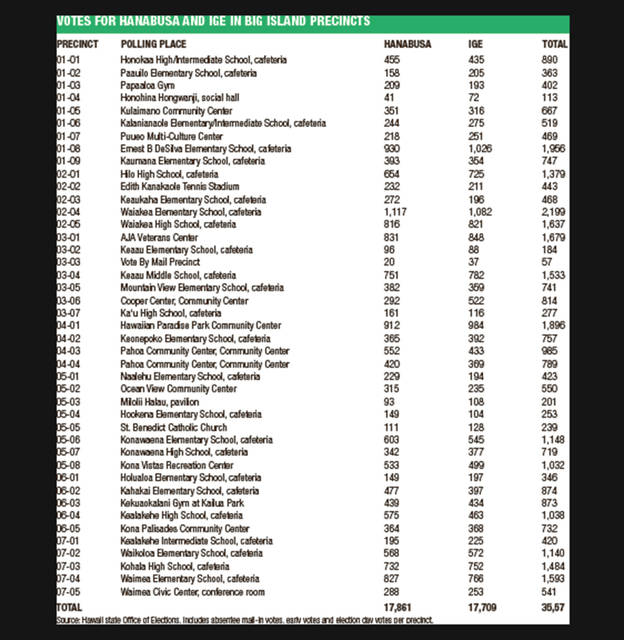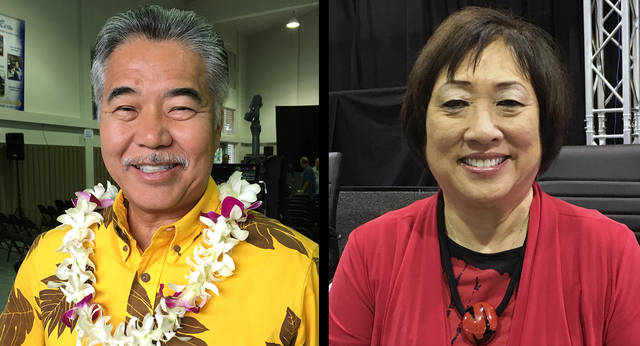The Big Island, especially West Hawaii and some areas in Puna, preferred U.S. Rep. Colleen Hanabusa over incumbent Gov. David Ige in Saturday’s Democratic primary election.
A precinct-by-precinct analysis of Big Island votes showed, at least this election, the votes pretty much followed the money. There were no real surprises on the island come election day, as precinct votes closely tracked a July 29 West Hawaii Today/Tribune-Herald analysis of campaign contributions by ZIP code.
The money analysis looked at in-state contributions reported to the Hawaii Campaign Spending Commission between Sept. 1, when Hanabusa set up her state campaign fund, and June 30.
That’s despite cautions from several political analysts that contribution amounts aren’t a clear indicator of likely votes. The newspapers offered the analysis to get a glimpse at the candidates’ support base in a race that, at the time, was too close to call.
“I don’t know, it’s certainly looking to be, at least in hindsight this time, as a pretty strong predictor,” said Colin Moore, associate professor of political science and director of the Public Policy Center at the University of Hawaii at Manoa.
The ZIP code level money analysis showed Ige with strong money support in Hilo proper up to Honokaa, as well as Volcano, Naalehu and into South Kona. Hanabusa’s support base was in Puna and most of West Hawaii, including all of Kailua-Kona and Waimea.
Hanabusa held those same areas in votes as well, while Ige’s support base was strongly Hilo, according to the precinct analysis.
In fact, Ige held just East Hawaii House Districts 1, 2 and 3, and Hanabusa picked up the other four. In all, Hanabusa garnered 17,861 Big Island votes to Ige’s 17,709.
But Hanabusa voters’ enthusiasm, along with that of most Maui voters, wasn’t enough to overcome high Ige votes in Oahu population centers and the much smaller voter population of Kauai.
When all the ballots were counted, Ige won by almost 17,000 votes, or 51 percent of the votes to Hanabusa’s 44 percent. He now faces Republican Andria Tupola and a few lesser party candidates in the Nov. 6 general election.
It’s understandable that voters in Puna precincts struck hardest by the lava flows from the Kilauea volcano eruption and frustrated with emergency response might vote for someone other than the guy in charge. Mayor Harry Kim’s last-minute endorsement of Ige in a TV commercial with the crisis as a backdrop might have been too little, too late for those voters.
The question of why West Hawaii and North Hawaii precincts preferred Hanabusa with money and votes, however, remains a mystery. Those areas spurned Hanabusa in favor of U.S. Sen. Brian Schatz in her narrow loss in a storm-tossed 2014 primary.
“I’m surprised it was such an obvious difference,” Moore said. “The odd thing about this is that Hanabusa is seen as part of the old Democratic machine,” which could be seen as an oddity in an area with more recent settlers and part-time residents.
Hanabusa’s campaign team had little to add to help clear up the mystery.
“Congresswoman Hanabusa is focused on her work in Washington, D.C., during the final months of the 115th Congress,” her campaign staff said in an email. “She is supporting Gov. David Ige in the coming General Election.”
Nor did Ige’s.
“The governor worked very hard in every part of this state to reach as many voters as possible with his message of improving our public schools, environment, our economy and more,” a spokeswoman said in an email. “Governor Ige is extremely grateful to everyone who turned out to vote and will work hard to earn their support again this fall.”
Email Nancy Cook Lauer at ncook-lauer@westhawaiitoday.com.


